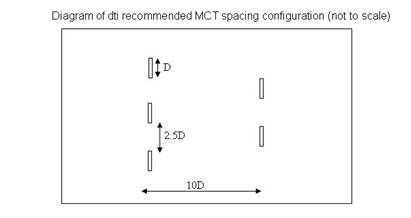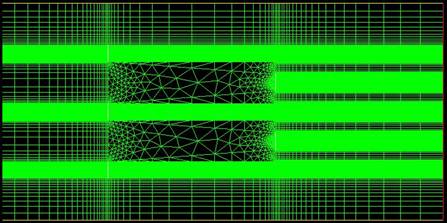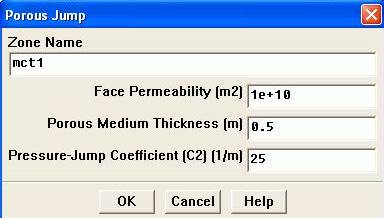CFD Model Methodology
Aims and objectives
Aim of using CFD model is to:
- Validate values of K T from the channel model
- Provide verification that Betz approach is valid
- Provide a cursory look at the significance of the channel model’s failure to account for interaction between MCT’s
Methodology
Pre-processing:
It was decided to construct a 2-D model geometry to represent an array of 5 MCT’s with a spacing configuration identical to the dti recommendations shown below:

This 2D model was then used to construct and mesh a grid structure using Gambit. The MCT’s were defined as porous jumps with a value of porosity shown in the Appendix. All zones in the domain were defined as water (liquid) with a velocity inlet and a pressure outlet being defined at the left-hand and right-hand edges respectively. The upper and lower edges were defined as edges of symmetry.

Once the creation of the model was complete, the grid was exported into Fluent 5.5. The simulation and boundary conditions were then set as shown below
- Define-models-solver-2D-segregated-implicit-steady state
- Define materials- select water(liquid) from database
- Define operation conditions- atmospheric pressure
- Define boundary conditions
- Inlet- input actual channel velocity at certain time step
- Outlet- set to 0 Pa
- Water- fluid
- MCT’s 1-5- as shown below

- The permeability was set to a high value so as to negate the viscous coefficient and thus account for only frictional loss
- The thickness was set to 0.5 m as this was assumed to be the approximate thickness of the swept area of the rotor
- The value of the frictional loss coefficient C2 was calculated to be 25 (see Appendix for working)
- Define-model- energy not selected
- Define-model –Viscous- k-epsilon (2 eqn)
- Solve-monitors- residual-300 iterations
- Solve-initialise- initialise from inlet
- Report-reference values- compute from inlet
- Interate- 300 iterations were sufficient in terms of achieving convergence of the solution
The inlet velocity was specified according to the actual channel velocity values for the Pentland Firth channel. The fluent code was then resolved for 300 iterations.
Back to top |

